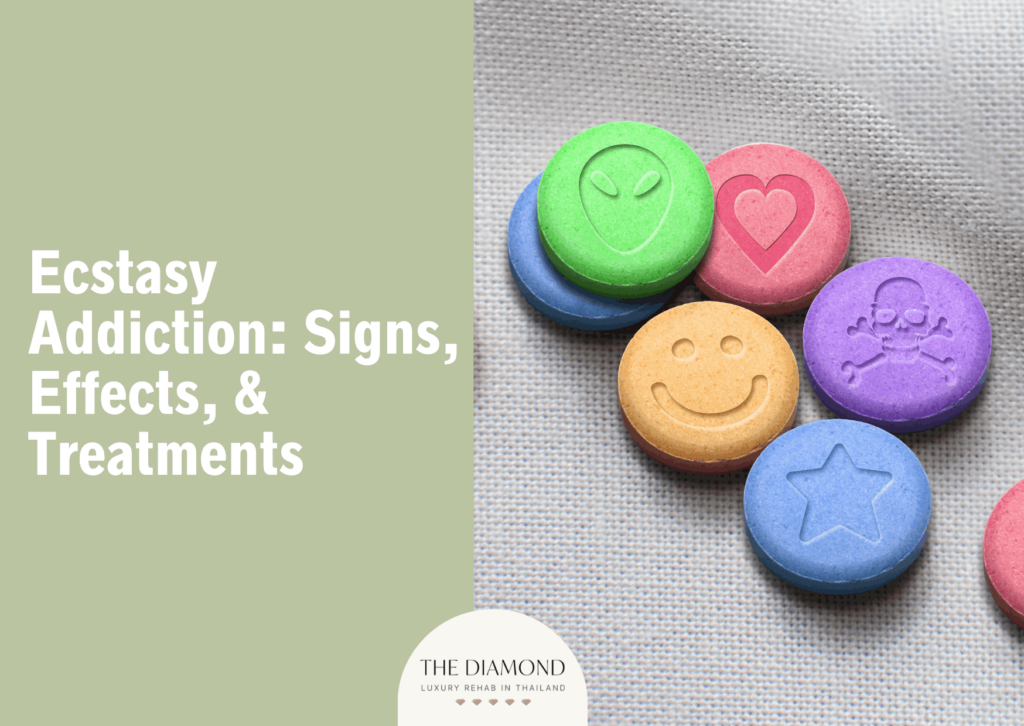Ecstasy addiction: signs, effects, and treatments

Ecstasy is a stimulant drug that causes hallucinations and changes a person’s perception of reality. It is one of the most frequently used club drugs. Numerous people develop an addiction to ecstasy.
Signs of ecstasy addiction are strong cravings for the drug, developing tolerance and increasing the amounts to experience the same effects, spending a lot of time and money on ecstasy, losing interest in activities once enjoyed, changing social circle, and continuing to use ecstasy despite interpersonal problems and physical or psychological health issues it causes.
The effects of ecstasy are either short-term or long-term. Short-term effects include anxiety and depression, changes in blood pressure and heart rate, difficulty sleeping, blurred vision, and dilated pupils. Long-term effects of ecstasy include kidney problems, memory loss, cardiovascular collapse, cognitive problems, psychosis, and suicidal thoughts and tendencies.
What is ecstasy addiction?
Ecstasy addiction is a type of physical addiction where a person has the overpowering need to keep using ecstasy despite the problems and consequences it causes. It is otherwise known as ecstasy use disorder, MDMA addiction, or MDMA use disorder.
The American Psychiatric Association’s Diagnostic and Statistical Manual of Mental Disorders, fifth edition ❲DSM-5❳ categorizes ecstasy addiction in the section called Other Hallucinogen Use Disorder.
Ecstasy, methylenedioxymethamphetamine or MDMA, is a synthetic drug known for stimulant and hallucinogenic effects. It produces an energizing effect, distorts time and perception, and amplifies the enjoyment of tactile experiences.
Although MDMA pills are a well-known club drug today, the drug was initially developed as a parent compound to synthesize medications that regulate bleeding. A German pharmaceutical company developed MDMA back in 1912.
What are the street names for ecstasy?
Street names for ecstasy refer to the various colloquial terms used to describe the recreational drug when sold and used illegally. The street names for ecstasy are listed below:
- Molly
- Adam
- Beans
- Disco biscuit
- Clarity
- E
- Eve
- Hug drug
- Go
- Lover’s speed
- X
- E
- XTC
- STP
- Peace
- MDMA
- California sunrise
- Candy
- Elephants
- Essence
- Love drug
- Love pill
- Snowball
- Scooby snacks
- Roll
- Rave
What are the signs of ecstasy addiction?

Signs of ecstasy addiction are multifaceted and commonly comprise both physiological and behavioral manifestations. The signs of ecstasy addiction are listed below:
- Strong cravings for ecstasy
- Taking ecstasy for longer than intended and in larger amounts
- Developing tolerance to ecstasy and increasing the use to experience the same effects
- Unsuccessful attempts to stop using ecstasy
- Spending a lot of time and money on buying, using, and recovering from ecstasy use
- Neglecting work, school, and other daily responsibilities due to ecstasy use
- Using ecstasy in dangerous or risky situations e.g. while operating heavy machinery or driving
- Losing interest in activities once enjoyed, social withdrawal
- Continuing to use ecstasy despite interpersonal problems causes
- Continuing to use ecstasy despite physical and psychological problems causes
- Changes in social circle
- Lying or secretive behavior
- Legal problems and financial difficulties due to ecstasy use
- Highly energetic behavior
What are the possible causes of ecstasy addiction?
Possible causes of ecstasy addiction are unclear, like with other types of substance use disorders. It’s highly likely that a combination of different factors plays a role in the development of ecstasy addiction rather than a single cause alone. The potential causes of ecstasy addiction are listed below:
- Genetics: Family history is a major risk factor for the development of substance use disorders, including ecstasy addiction. In fact, according to a 2022 study by Alhammad et al., published in Cureus, genetics play a part in substance abuse; specific genetic variants have been associated with a higher likelihood of addiction. That means a person is more likely to develop ecstasy addiction if their family member, especially a parent or sibling, struggles with substance abuse as well. Certain people have a genetic predisposition to develop an addiction. It’s not a single genetic mutation that causes problems such as ecstasy addiction, but multiple genes are involved.
- Environment: A person’s environment has a substantial influence on their behaviors and contributes to the development of ecstasy addiction. People who were raised in unsafe, dysfunctional homes are more prone to substance abuse as a way to cope with trauma. Peer pressure additionally leads to ecstasy addiction as a person feels pressured to keep using the drug in order to be accepted by their social circle. The use of drugs such as ecstasy is glorified on social media and in movies or TV shows, which plays a role in addiction, as a person feels there’s nothing wrong with using it. Other environmental factors in the development of ecstasy addiction include easy access to the drug, socioeconomic status (middle class or upper class), and a party-loving lifestyle.
- Brain changes: Ecstasy influences functions in the brain, just like other drugs. It causes a greater release of serotonin and norepinephrine than dopamine. The main role of the serotonin neurotransmitter is to regulate mood, appetite, pain, and sleep. Excessive release of serotonin leads to mood-elevating effects of ecstasy. With time, receptors in the brain weaken, and greater amounts of the drug are necessary to experience the same effects. This leads to problematic use, dependence, and addiction.
What are the side effects of ecstasy?
The side effects of ecstasy are classified into short- and long-term. The side effects of ecstasy are listed in the table below.
| Side effects of ecstasy | |
|---|---|
| Short-term side effects | Long-term side effects |
| Impaired judgment or loss of inhibition | Nerve degeneration |
| Anxiety and/or depression | Psychosis |
| Paranoia | Kidney failure |
| Confusion | Anxiety and/or depression |
| Difficulty sleeping | Memory loss |
| Blurred vision and pupil dilation | Hemorrhaging |
| Muscle tension | Long-lasting brain damage |
| Teeth grinding or clenching | Convulsions |
| Auditory or visual hallucinations | Cardiovascular collapse |
| Increased heart rate and blood pressure | Cognitive issues e.g. difficulties with executive processing, problem-solving, emotional intelligence, etc. |
| Elevated body temperature | Suicidal thoughts and tendencies |
| Increased sex drive | Death |
How is ecstasy addiction diagnosed?

Ecstasy addiction is diagnosed like other substance use disorders. A thorough evaluation is necessary, which is why a doctor asks about symptoms and medical history and performs a physical exam. The main purpose of a physical exam is to rule out health problems that possibly cause similar symptoms.
The doctor is likely to order a blood or urine test to look for the presence of drugs. In addition, they refer a patient to a psychiatrist who performs a psychiatric evaluation. Interviewing family members to get a deeper understanding of a patient’s behavior is another possible scenario during the process of getting a diagnosis.
In order to diagnose ecstasy addiction, the psychiatrist relies on DSM-5 and makes sure the patient meets the diagnostic criteria listed in this manual, according to a 2022 article titled, “Drug addiction (substance use disorder) from Mayo Clinic.
Diagnostic criteria for ecstasy addiction i.e., other hallucinogen use disorder, indicates exhibiting at least two symptoms from DSM-5 within 12 months. These criteria include continuing to use ecstasy despite social or interpersonal problems, using ecstasy despite physical or psychological problems, having strong cravings for ecstasy, and falling behind at work, school, and other responsibilities due to ecstasy.
Other criteria include losing interest in activities once enjoyed, spending a lot of time getting, using, or recovering from ecstasy, taking more ecstasy than intended, using ecstasy in dangerous situations, and developing a tolerance for ecstasy.
What are the ecstasy addiction statistics?
Ecstasy addiction statistics indicate that in 2021, 0.8% of individuals above the age of 12 (or over 2.2 million) reported using MDMA (Ecstasy) within the previous 12 months, according to a 2017 publication from the National Institute on Drug Abuse titled, “What is the scope of MDMA use in the United States?”.
Furthermore, a publication titled, “Number of people in the U.S. who used ecstasy (MDMA) in the past year from 2009 to 2021” released in January 2023 by Statista indicated that approximately 21.1 million Americans reported having used MDMA at some point in their lives as of 2021. In addition, about 594,000 individuals said they had used MDMA within the previous month.
At the same time, a 2017 report titled, “MDMA: use continues to increase” from the European Monitoring Centre for Drugs and Drug Addiction stated that 4.2% of people aged 15 to 64 years reported ecstasy use at a certain point in their lifetime. In other words, at least 14 million Europeans have tried ecstasy at least once. Young adults (15-34) are most likely to use ecstasy, according to their report.
What are the Ecstasy withdrawal symptoms?
Ecstasy withdrawal symptoms vary from one person to another mainly because people tend to use it in combination with other substances or it is cut with other drugs such as ketamine and heroin. The most common ecstasy withdrawal symptoms are listed below:
- Cravings for ecstasy
- Anxiety and/or depression
- Confusion
- Paranoia
- Agitation and irritability
- Memory problems
- Fatigue
- Trouble concentrating
- Reduced appetite
- Self-perception changes
What are the treatments available for Ecstasy addiction?
Treatments available for ecstasy addiction are tailored to the affected individual and their specific needs. The available treatments for ecstasy addiction are listed below:
- Detox: The first phase of addiction treatment which involves abrupt cessation of ecstasy use. As a person stops taking the drug, the body and brain respond through withdrawal symptoms as they try to adapt to the absence of ecstasy. Detox is performed under medical supervision for patient safety. At this point, there are no approved medications to treat ecstasy addiction, but doctors prescribe therapies for the management of other symptoms, such as depression. Since detox is the first stage of the recovery process, patients continue the treatment through adequate programs.
- Inpatient treatment: The patient is admitted to an addiction treatment center, where they stay until their treatment program completes. People usually spend 30, 60, or 90 days in rehab centers. During their treatment, patients receive different types of therapy. Cognitive-behavioral therapy, or CBT, is the most common type of psychotherapy and is known as the most effective. The main purpose of CBT is to help patients identify negative thoughts that lead to unhealthy emotions and behaviors, then replace them with realistic and more positive alternatives. Healthier thought patterns lead to healthier behaviors. During CBT sessions, patients learn skills that help them recover and prevent relapse. According to a 2017 report titled, “How are MDMA use disorders treated?” from the National Institute on Drug Abuse, CBT aids patients in developing coping skills against life stressors. In addition to individual therapy, patients attend group therapy sessions as well. A study by Watkins et al., published in the June 2011 issue of the Archives of General Psychiatry confirmed that CBT is effective in group settings, promotes substance abuse treatment, and helps manage depression.
- Outpatient treatment: The non-residential type of program, i.e. the patient doesn’t live in a rehab center. The patient lives at home, maintains employment, and attends therapy sessions regularly. Outpatient treatment includes individual therapy and group therapy, and relies on several approaches, mainly CBT. These programs are suitable for people whose addiction isn’t severe or patients who have completed an inpatient program but need more guidance to prevent relapse.
- Support groups: a major aspect of addiction treatment. During group meetings, patients share their experiences with recovery, the challenges they face, and the obstacles they have overcome. In addition to sharing experiences, people in support groups offer support to others, which is important for recovery. Support groups provide the opportunity to learn, increase confidence, and work on sobriety.


